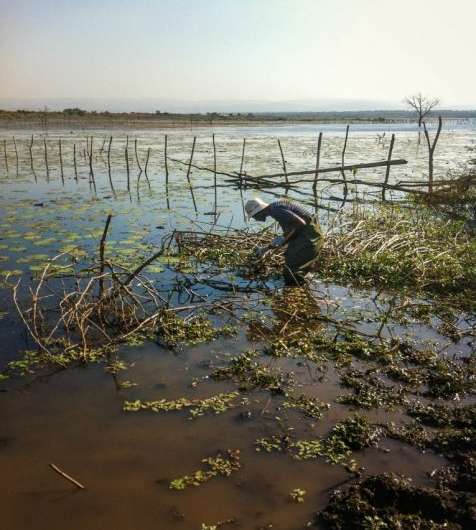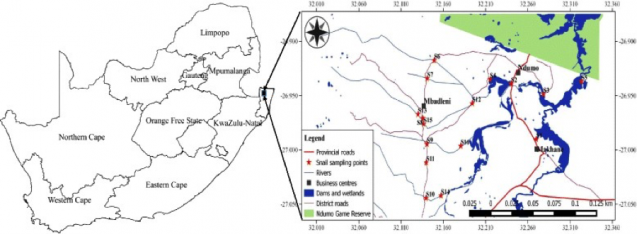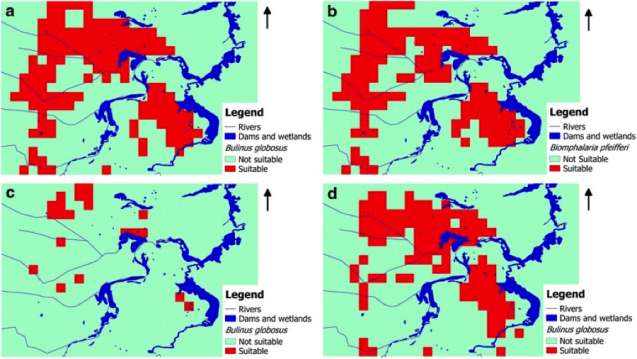New model helps in fight against deadly parasitic disease

Cole Porter romanticized the phrase in his 1936 song, but the probable origin of having someone—or something—under one's skin is much less pleasant to consider. An early usage of the phrase by author Bayard Taylor in 1864 illustrates: "The idea was like a tropical sand-flea. It had got under my skin, and the attempt to dislodge it opened the germs of hundreds of others." Today, in some water bodies, the possibility of going in for a swim and coming out with a disease-causing parasite lodged under the skin remains all too real.
One such parasite is the flatworm belonging to the genus Schistosoma, commonly known as a blood-fluke. The flatworm is responsible for schistosomiasis, a disease that occurs in areas with poor sanitation where humans can come into contact with freshwater contaminated with the parasite. Schistosomiasis causes a range of symptoms including anemia, stunted growth, malnutrition, fibrosis, kidney failure, gastrointestinal illness and lesions to the central nervous system. The Centers for Disease Control and Prevention says that in terms of impact of parasitic diseases, schistosomiasis is second only to malaria and is the most deadly of the neglected tropical diseases. More than 700 million people, mostly Africans, live in areas where the disease is endemic. Around 240 million people are infected with schistosomiasis and more than 200,000 die from it every year.
Scientists from Columbia University's International Research Institute for Climate and Society and the University of KwaZulu-Natal (UKZN) in South Africa are trying to put a dent in these numbers. They have developed a new model based on data from satellites that helps identify areas likely to contain species of freshwater snails that serve as host to Schistosoma larvae. They published the results in a recent paper in the journal Parasites and Vectors.
"This could enable health workers to target areas that are especially likely to have an outbreak and make efforts more effective where resources are limited," says Pietro Ceccato, who led the work at IRI.
Schistosoma larvae use the snails to develop and multiply, and eventually re-enter water bodies to seek out human hosts and burrow into their skin. After a person is infected, the parasites enter the blood stream and travel to the liver, where they mature into adult worms and reproduce. Many of the resulting eggs will be release with feces and urine and make it back to a water body where snails live, and so the cycle continues.

Without the presence of these snails, any Schistosoma in a body of water will die before fully maturing, thus essentially eliminating the risk of humans contracting schistosomiasis.
The researchers focused on an area in the uMkhanyakude district of South Africa. They discovered that the snails are most likely to be found where there is slow moving surface water with slightly higher-than-normal temperatures. But the snails can also hibernate when the pools get dry and then repopulate during and after the rainy season, said UKZN's Tawanda Manyangadze, the lead author of the study. Such pools are often those people enter and then come into contact with the parasite, he said.
Using the new model, the researchers tested variables such as air temperature, rainfall, water velocity (as estimated by the slope of ground) and soil pH, among others, to try to predict where the snails would be found, and then compared those findings with sampling of snails in the field. They found that the best predictor of where snails are present is a measure called the Normalized Difference Water Index (NDWI), which estimates the presence of surface water bodies based on satellite data and a mathematical formula.
NDWI is one of the methods for mapping water bodies that Ceccato and his team designed using images from LANDSAT and MODIS, which are both NASA satellites. The funding for their work came from a NASA SERVIR project, and the methods they've developed are now used in various applications—from monitoring breeding reservoirs to the impact of floods.
The mapping techniques are particularly useful in areas with distinct dry and wet seasons, where temporary bodies of water may form in some years but not others, and sometimes in different locations. Ceccato, a co-author on the study, said they were able to successfully map the seasonality of the water bodies at a high spatial resolution, and thus map the corresponding suitability of the habitat for snail development.

The maps produced by the model can help health workers narrow-in on where the risk of schistosomiasis may be high. With that information, they can take actions such as stockpiling medications that interrupt the parasite's cycle, controlling snail populations and launching awareness campaigns. Without such a model, much more time and resources must be spent to send surveyors to identify areas of probable risk.
Manyangadze's team is promoting the model to local decision makers. "We are working toward improving our model and applying it to the whole of the uMkhanyakude health district by collaborating with the Department of Health in South Africa. This is promising to be a useful tool for planned large-scale distribution of medication," he said.
The World Health Organization estimated that out of the 218 million people who required preventive treatment in 2015, only 66.5 million received it.
Manyangadze noted that other variables not tested in this study could also be important for snail habitat suitability, such as the chemistry of the water and whether or not plants are present in the water. Incorporating these variables could help them narrow down the risk areas even further.
"Through our collaboration with IRI, we are planning to do further work on the use of satellites to detect water levels, aquatic plants and turbidity as that information relates to the presence and abundance of snails," he said.
More information: Tawanda Manyangadze et al. Modelling the spatial and seasonal distribution of suitable habitats of schistosomiasis intermediate host snails using Maxent in Ndumo area, KwaZulu-Natal Province, South Africa, Parasites & Vectors (2016). DOI: 10.1186/s13071-016-1834-5
Provided by Earth Institute, Columbia University
This story is republished courtesy of Earth Institute, Columbia University: blogs.ei.columbia.edu .


















